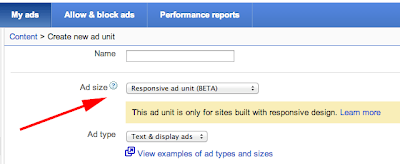How to Make Google AdSense Ad Units Responsive
How to Make Google AdSense Ad Units Responsive
New trend in blogging platform
is responsive style. Now most of the blogger diverting on responsive template. But
actually what is responsive? I can explain you simply that responsive is a
style which can be adjust within any resolution of device. Such as Desktop, laptop,
Smart phone, palmtop, smart tab related
device. more clearly, Responsive web design allows you to vigorously control
the display of your blog or website according to the screen/device. That means
a blogger template can be seen easily in any device. So apart from this you have
to think about your other things that should be responsive otherwise your
template can't be properly display in all device. Advertise is a biggest thing
which we must make responsive to make our blog pure responsive.
Early in August 2013 Google
AdSense officially introduced ad support with Responsive Style. By using a
responsive ad unit, you can control the size of the ads on your any section. But
this is still in the Beta version of the stage but it need to develop more. Because
AdSense ads are doesn't match the size with the pixels. Responsive AdSense does
not flow and roll up like a Responsive apparently on images and video.
For example we want to display
the ads whose max-width: 350px that means we have to determine who is
advertising supported and in accordance with this resolution, Suppose we have
added 728px X 90px Ad unit and when we will watch in smart tab then it will
turn into 468px X 60px ad unit.
Now I am providing an example
below by a standard source code of AdSense (320px X 50px) in responsive mode-
<style>
.bs-responsive { width: 320px; height: 50px; }
@media(min-width: 500px) { .bs-responsive { width: 468px; height: 60px; } }
@media(min-width: 800px) { .bs-responsive { width: 728px; height: 90px; } }
</style>
<script async src="http://pagead2.googlesyndication.com/pagead/js/adsbygoogle.js"></script>
<!-- OOM-RESPONSIVE -->
<ins class="adsbygoogle bsm-responsive"
style="display:inline-block"
data-ad-client="ca-pub-xxxx"
data-ad-slot="yyyy"></ins>
<script>
(adsbygoogle = window.adsbygoogle || []).push({});
</script>
How to modify it to display Adsense Responsive?
So now I will explain how to modify all of AdSense ad units in responsive way. To make
responsive we have to modify the CSS and have to select which ads we want to displayed
according to their size in media queries-
<style>
@media(min-width: 240px) { .bs-responsive { width: 234px; height: 60px; } }
@media(min-width: 320px) { .bs-responsive { width: 250px; height: 250px; } }
@media(min-width: 480px) { .bs-responsive { width: 468px; height: 60px; } }
@media(min-width: 768px) { .bs-responsive { width: 728px; height: 90px; } }
@media(min-width: 1024px) { .bs-responsive { width: 468px; height: 60px; } }
@media(min-width: 1216px) { .bs-responsive { width: 728px; height: 90px; } }
</style>
<div style="text-align:center">
<script async src="http://pagead2.googlesyndication.com/pagead/js/adsbygoogle.js"></script>
<!-- BS-RESPONSIVE -->
<ins class="adsbygoogle oom-responsive"
style="display:inline-block"
data-ad-client="ca-pub-xxxx"
data-ad-slot="yyyy"></ins>
<script>
(adsbygoogle = window.adsbygoogle || []).push({});
</script>
</div>
In the above code you would find first part is CSS which
is under <style>.......</style> and <div...........</div>
is the main ads code which will provide by Google AdSense.
How to Make Google AdSense Ad Units Responsive with JavaScript?
I am also providing a trick that you can make your
AdSense responsive with Java Script. This trick is pretty cool that will work
automatically in all of your AdSense ad units.
<div id="adsbygoogle">
<script type="text/javascript">
adUnit = document.getElementById("adsbygoogle");
adWidth = adUnit.offsetWidth;
google_ad_client = "ca-pub-number";
if ( adWidth >= 770 ) {
/* Leaderboard 728x90 */
google_ad_slot = "Ad Slot number";
google_ad_width = 770;
google_ad_height = 90;
} else if ( adWidth >= 468 ) {
/* Banner (468 x 60) */
google_ad_slot = "Ad Slot number";
google_ad_width = 468;
google_ad_height = 60;
} else if ( adWidth >= 336 ) {
/* Large Rectangle (336 x 280) */
google_ad_slot = "Ad Slot number";
google_ad_width = 336;
google_ad_height = 280;
} else if ( adWidth >= 300 ) {
/* Medium Rectangle (300 x 250) */
google_ad_slot = "Ad Slot number";
google_ad_width = 300;
google_ad_height = 250;
} else if ( adWidth >= 250 ) {
/* Square (250 x 250) */
google_ad_slot = "Ad Slot number";
google_ad_width = 250;
google_ad_height = 250;
} else {
/* Ad Link Unit (200 x 90) */
google_ad_slot = "Ad Slot number";
google_ad_width = 200;
google_ad_height = 90;
}
</script>
<script type="text/javascript"
src="http://pagead2.googlesyndication.com/pagead/show_ads.js">
</script>
</div>
Customization
- Replace ca-pub-number with AdSense cab publication number.
- Replace Ad Slot number with AdSense ad slot number.
So I hope this tutorial help your to make your AdSense
pure responsive until releasing of full version of Google. If you have any
suggestion please share with us.



8 comments
Hoping to Get More tutorials From You :)
I Have started new blog also visit my blog
http://probloggerwidgets.blogspot.com/
I suggest create your site about Game review but not copy and paste from other site. And carefully read my following article about blogging niche...
http://www.bloggerspice.com/2013/06/how-to-choose-right-niche-before-start.html
if you want o earn money from your blog then you must be genuine blogger. I have seen you are using bidviser but to make $100 by bidviser it requires almost 5 years.
https://www.google.com/adsense/localized-terms?hl=en_GB
There are many site got approval but they make review after short period of time. So don't think that your AdSense approved account will be last long.
Beside of this there are many AdSense account that disable before making payment only for violating terms and conditions.